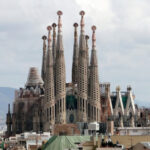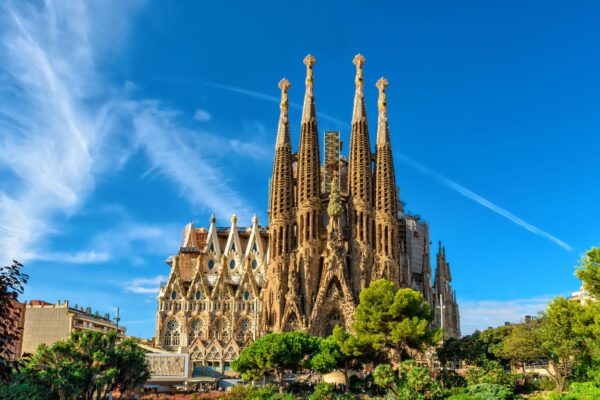
- The Architectural Marvel of Barcelona's Sagrada Familia: A Historical Overview
- The Symbolism Behind the Sagrada Familia's Design Elements
- Exploring the Influence of Antoni Gaudí on the Sagrada Familia's Construction
- The Ongoing Journey: How the Sagrada Familia is Being Completed
- Visitor Experience: Why the Sagrada Familia is a Must-See Attraction in Barcelona
Barcelona's Sagrada Familia stands as a testament to the genius of architect Antoni Gaudí, captivating millions with its unique blend of Gothic and Art Nouveau styles. This monumental basilica, still under construction over a century later, symbolizes the city's rich cultural heritage and architectural innovation.
In exploring The Fascinating History of Barcelona's Sagrada Familia, one uncovers a narrative filled with ambition, devotion, and a relentless pursuit of artistic perfection. From its groundbreaking in 1882 to its anticipated completion, the Sagrada Familia is not just a church; it is a story woven into the fabric of Barcelona itself.
The Architectural Marvel of Barcelona's Sagrada Familia: A Historical Overview
The architectural marvel of Barcelona's Sagrada Familia is not only a hallmark of Gaudí's genius but also a beacon of innovation during its time. Characterized by its intricate facades and towering spires, this basilica integrates natural forms and religious symbolism. The design reflects Gaudí's vision of merging spirituality and nature, evident in elements such as the tree-like columns that support the nave and the stunning light effects created by stained glass windows.
A key aspect of the Sagrada Familia's history is its construction timeline, which reveals the challenges and triumphs faced by its builders. Here are some notable milestones in its journey:
- 1882: Groundbreaking and initial design by Francisco de Paula del Villar.
- 1883: Antoni Gaudí takes over as chief architect.
- 1926: Gaudí's tragic death; construction continues under various architects.
- 2026: Projected completion date, coinciding with the centenary of Gaudí's death.
The Sagrada Familia's architectural significance is further accentuated by its use of geometric forms and innovative structural techniques. Gaudí employed a unique method of modeling, known as the "hanging chain model," allowing him to visualize the forces acting on the structure. This approach not only enhances the building's stability but also contributes to its organic aesthetic, setting it apart from traditional Gothic cathedrals.
In addition to its artistic innovations, the Sagrada Familia has become a cultural icon that draws visitors from around the globe. Its impact is evident in Barcelona's landscape and tourism, shaping the city's identity. The basilica has also been recognized as a UNESCO World Heritage Site, securing its place in history as a masterpiece of architectural achievement.
The Symbolism Behind the Sagrada Familia's Design Elements
The design elements of the Sagrada Familia are rich with symbolism, reflecting a deep spiritual narrative intertwined with nature and faith. Gaudí believed that architecture should mimic the natural world, which is evident in the basilica's organic shapes and structures. For instance, the columns resemble trees, symbolizing growth and life, creating a sense of being within a forest that connects the divine and the earthly.
Moreover, the façades of the Sagrada Familia encapsulate different aspects of Jesus' life, each representing a unique theological theme:
- The Nativity Façade: Celebrates the birth of Jesus, filled with intricate carvings that depict scenes of joy and warmth.
- The Passion Façade: Represents the suffering and crucifixion of Christ, characterized by stark, angular forms that evoke a sense of anguish.
- The Glory Façade: Under construction, it will symbolize the resurrection and glory of Jesus, intended to be a triumphant culmination of the entire structure.
Another striking feature is the use of light throughout the basilica, which plays a crucial role in its symbolism. The stained glass windows are designed to filter light in a way that bathes the interior in a spectrum of colors, reminiscent of the divine light of heaven. This interplay of light and shadow is intended to evoke emotional responses, guiding visitors towards reflection and spirituality.
Ultimately, the Sagrada Familia serves as a profound manifestation of Gaudí's vision, where every design element embodies a deeper meaning. It invites exploration not only of its physical beauty but also of the spiritual journey it represents, making it a pilgrimage site for those seeking a connection with the sacred.
Exploring the Influence of Antoni Gaudí on the Sagrada Familia's Construction
Antoni Gaudí's influence on the Sagrada Familia is profound and multifaceted, shaping not only its aesthetic but also its structural integrity. His innovative approach to design was rooted in his admiration for nature, which he believed should guide architectural forms. By integrating organic shapes into the basilica, Gaudí created a structure that feels alive, harmonizing with its surroundings.
One of the most significant contributions Gaudí made to the Sagrada Familia is his pioneering use of geometry. He employed methods such as hyperboloid structures and catenary arches, which not only provided aesthetic beauty but also enhanced the building's stability. This unique approach allowed the basilica to rise to unprecedented heights while remaining structurally sound.
Additionally, Gaudí's deep Catholic faith profoundly influenced the symbolism embedded within the Sagrada Familia. He designed the basilica to be a visual representation of biblical stories, with each element narrating aspects of Christian theology. Key influences include:
- Natural Forms: Reflecting God's creation and the interconnectedness of life.
- Religious Symbolism: Each façade tells a part of Christ's life, serving both as a visual guide and a source of spiritual reflection.
- Light Integration: The strategic placement of windows enhances the spiritual experience, creating an ambiance that invites contemplation.
Gaudí’s commitment to his vision was evident in his immersive design process, which often involved hands-on experimentation. He famously used scale models and hanging chains to study the forces of gravity on structures, leading to creative solutions that set the Sagrada Familia apart from conventional architectural practices. This methodology not only showcases Gaudí's genius but also serves as a lasting legacy in the world of architecture.
The Ongoing Journey: How the Sagrada Familia is Being Completed
The journey towards the completion of the Sagrada Familia is a remarkable testament to both human perseverance and architectural ambition. As construction continues into the 21st century, the project embraces modern technology while adhering to Gaudí's original vision. Today, advanced techniques such as computer-aided design and 3D printing are employed to replicate the intricate details envisioned by the architect, ensuring fidelity to his groundbreaking style.
One of the key aspects of this ongoing journey is the collaboration between various architects and artisans who strive to maintain the authenticity of Gaudí's work. Their efforts include:
- Research and Documentation: Analyzing Gaudí's original sketches and models to guide contemporary builders.
- Material Innovation: Utilizing modern materials that provide durability while harmonizing with the original stone.
- Community Engagement: Involving local artisans and craftsmen to foster a sense of ownership and connection to the basilica.
Furthermore, the anticipated completion date in 2026 marks a significant milestone, coinciding with the centenary of Gaudí's passing. This date is projected to be celebrated with elaborate ceremonies, as it symbolizes not just the end of construction but also the realization of a collective dream that has transcended generations. The completion will allow visitors to fully experience the profound spiritual and architectural significance that the Sagrada Familia embodies.
As the basilica evolves, it continues to inspire awe and reverence, representing a bridge between the past and the future. The dedication to completing the Sagrada Familia reflects a broader commitment to preserving cultural heritage, while simultaneously embracing innovation, making it a living monument to Gaudí's extraordinary legacy.
Visitor Experience: Why the Sagrada Familia is a Must-See Attraction in Barcelona
Visiting the Sagrada Familia is an unforgettable experience that captivates the senses and inspires reflection. As one approaches the basilica, its towering spires and intricate facades create a breathtaking first impression. The stunning interplay of light and shadow within the interior, crafted by the spectacular stained glass windows, invites visitors to pause and absorb the spiritual energy that permeates the space.
Moreover, the Sagrada Familia offers a unique opportunity to witness the ongoing evolution of a monumental masterpiece. Unlike typical attractions, this basilica is a living project, where guests can observe skilled artisans and craftsmen at work, dedicated to honoring Gaudí's vision. The interactive exhibitions provide context and insight into the architectural techniques and symbolism embedded throughout the structure, enhancing the overall visitor experience.
Additionally, the Sagrada Familia serves as a cultural hub, often hosting concerts and events that highlight its musical and artistic significance. The acoustics within the basilica are remarkable, allowing for an immersive auditory experience that complements the visual splendor. This multifaceted appeal makes the Sagrada Familia not just a sight to behold, but a vibrant space where art, spirituality, and community converge.
In summary, the Sagrada Familia is a must-see attraction in Barcelona for its unique combination of architectural beauty, spiritual depth, and living history. Visitors are not only witnesses to Gaudí's genius but also participants in a grand narrative that continues to unfold, making each visit a personal journey of discovery and reflection.
 Unveiling the Architectural Marvel: Exploring the Sagrada Familia in Barcelona
Unveiling the Architectural Marvel: Exploring the Sagrada Familia in Barcelona The Magnificent Sagrada Familia: A Brief Overview from Wikipedia Deutsch
The Magnificent Sagrada Familia: A Brief Overview from Wikipedia DeutschIf you want to know other articles similar to The Fascinating History of Barcelona's Sagrada Familia you can visit the category WHERE YOU CAN GO.
Deja una respuesta










Read more!